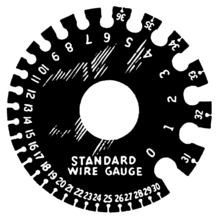|
Standard wire gauge
 The British Standard Wire Gauge, often referred to as the Standard Wire Gauge or simply SWG, is a unit used to denote wire gauge (size) as defined by BS 3737:1964, a standard that has since been withdrawn. It is also known as the Imperial Wire Gauge or British Standard Gauge. Although its use has significantly declined, SWG sizes are still used for measuring the thickness of guitar strings and certain types of electrical wire. In modern applications, wire size is more commonly measured in terms of cross-sectional area, expressed in square millimeters, particularly for electrical installation cables. The current British Standard for metallic materials, including wires and sheets, is BS 6722:1986, which exclusively uses metric measurements. HistorySWG was fixed by Order of Council August 23, 1883. It was constructed by improving the Birmingham Wire Gauge. It was made a legal standard on 1 March, 1884, by the British Board of Trade. SWG is not to be confused with American wire gauge, which has a similar but not interchangeable numbering scheme. StandardA table of the gauge numbers and wire diameters is shown below.[1][2] The basis of the system is the thou (or mil in US English), or 0.001 in. Sizes are specified as wire diameters, stated in thou and tenths of a thou (mils and tenths). The wire diameter diminishes with increasing size number. No. 7/0, the largest size, is 0.50 in. (500 thou or 12.7 mm) dia., No. 1 is 0.30 in. (300 thou), and the smallest, No. 50, is 0.001 in. (1 thou or 25.4 µm). The system as a whole approximates an exponential curve, plotting diameter against gauge-number (each size is a approximately a constant multiple of the previous size). The weight per unit length diminishes by an average of approximately 20% at each step. Because the weight per unit length is related to the cross sectional area, and therefore to the square of the diameter, the diameter diminishes by approximately 10.6%: However, the system is piecewise linear, only approximating the exponential curve loosely. Thus, it runs in constant steps of 0.4 thou (0.4 mil) through the range No. 49 - No. 39 and of 0.8 thou (0.8 mil) through No. 39 - No. 30.
See also
References
|
